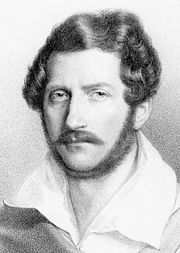
Summary
Maria de Rudenz is a dramma tragico, or tragic opera, in three parts by Gaetano Donizetti. The Italian libretto was written by Salvadore Cammarano, based on "a piece of Gothic horror",[1] La nonne sanglante by Auguste Anicet-Bourgeois and Julien de Mallian, and The Monk by Matthew Gregory Lewis. It premiered at La Fenice in Venice, on 30 January 1838.
| Maria de Rudenz | |
|---|---|
| Opera by Gaetano Donizetti | |
 Gaetano Donizetti c. 1835 | |
| Librettist | Salvadore Cammarano |
| Language | Italian |
| Premiere | 30 January 1838 La Fenice, Venice |
Performance history edit
19th century
While the initial performances were not very successful (Donizetti regarded them as "a fiasco"),[2] the opera was withdrawn after two performances.[1] It was given 14 performances in Rome in 1841 but, again, it was received with little enthusiasm.[2] Finally, an "excellent production and superior singing this time won vigorous approval"[2] in a production in Rome in 1841, and this was followed by one in Naples in 1848 at the Teatro Nuovo and three years later for a production at the Teatro San Carlo.
20th century and beyond
The opera did not receive a production in the UK until the Opera Rara concert presentation in London on 27 October 1974.[3] The first staged presentations in the 20th century took place at La Fenice beginning on 21 December 1980 with Katia Ricciarelli in the title role.[1] Both have been recorded. Among other performances, the opera was staged at the Donizetti Festival, Bergamo, in 2013[4] and by the Wexford Opera Festival in 2016.[5]
Roles edit
Napoleone Moriani (by Joseph Kriehuber)
| Role | Voice type | Premiere Cast, 30 January 1838 (Conductor: — ) |
|---|---|---|
| Maria de Rudenz | soprano | Carolina Ungher |
| Matilde di Wolf, her cousin | soprano | Isabella Casali |
| Corrado Waldorf | baritone | Giorgio Ronconi |
| Enrico, his brother | tenor | Napoleone Moriani |
| Rambaldo, old relative of the Rudenz house | bass | Domenico Raffaeli |
| The Chancellor of Rudenz | tenor | Alessandro Giacchini |
| Knights, squires, and vassals of the Rudenz house | ||
Synopsis edit
- Place: Switzerland
- Time: 1400[1]
Maria de Rudenz falls in love with Corrado against her father's wishes and flees with him to Venice. In Venice, Corrado suspects that Maria is unfaithful to him, abandons her, returns to Rudenz Castle, and falls in love with Maria's cousin Mathilde.
Maria returns to her ancestor's castle and discovers that her lover is not only going to marry her cousin, but that in fact he is also the son of a murderer. She is ready to keep his secret if only Corrado returns to her. Corrado refuses and in a rage injures her with his sword so that everyone thinks that she is dead.
On the wedding day of Mathilde and Corrado, Maria appears again. Maria reveals Corrado's secret to everyone, murders Mathilde, and commits suicide.
Recordings edit
| Year | Cast: Maria de Rudenz, Matilde di Wolf, Corrado Waldorf, Enrico |
Conductor, Opera House and Orchestra |
Label[6] |
|---|---|---|---|
| 1974 | Ludmilla (Milla) Andrew, Merril Jenkins, Christian Du Plessis, Richard Greager |
Alun Francis, Philomusica of London and the Opera Rara Chorus, (Recording of a concert performance in the Queen Elizabeth Hall, London, 27 October) |
CD: Memories, Cat: HR 4588-4589 |
| 1981 | Katia Ricciarelli, Silvia Baleani, Leo Nucci, Alberto Cupido |
Eliahu Inbal, Orchestra and Chorus of Teatro La Fenice, Venice, (Recorded at the La Fenice, Venice, January) |
CD: Fonit Cetra «Italia» Cat: CDC 91 Mondo Musica, Cat: MFOH 10708 Living Stage, Cat: LS 35140 |
| 1997 | Nelly Miricioiu, Regina Nathan, Robert McFarland, Bruce Ford |
David Parry, Philharmonia Orchestra and the Geoffrey Mitchell Choir |
CD: Opera Rara, Cat: ORC16 |
References edit
Notes
- ^ a b c d Osborne 1994, pp. 262-263
- ^ a b c Weinstock 1963, pp. 354-355
- ^ Ashbrook and Hibberd, p. 239
- ^ "Maria di Rudenz". gbopera.it. 23 September 2013. Retrieved 19 April 2018.
- ^ Dervan, Michael. "Maria de Rudenz Wexford Opera Festival review". The Irish Times. Retrieved 19 April 2018.
- ^ Recordings on operadis-opera-discography.org.uk
Sources
- Allitt, John Stewart (1991), Donizetti: in the light of Romanticism and the teaching of Johann Simon Mayr, Shaftesbury: Element Books, Ltd (UK); Rockport, MA: Element, Inc.(USA)
- Ashbrook, William (1982), Donizetti and His Operas, Cambridge University Press. ISBN 0-521-23526-X
- Ashbrook, William (1998), "Donizetti, Gaetano" in Stanley Sadie (Ed.), The New Grove Dictionary of Opera, Vol. Three, pp. 201–203. London: MacMillan Publishers, Inc. ISBN 0-333-73432-7 ISBN 1-56159-228-5
- Ashbrook, William and Sarah Hibberd (2001), in Holden, Amanda (Ed.), The New Penguin Opera Guide, New York: Penguin Putnam. ISBN 0-14-029312-4. pp. 224 – 247.
- Black, John (1982), Donizetti’s Operas in Naples, 1822—1848. London: The Donizetti Society.
- Loewenberg, Alfred (1970). Annals of Opera, 1597-1940, 2nd edition. Rowman and Littlefield
- Osborne, Charles, (1994), The Bel Canto Operas of Rossini, Donizetti, and Bellini, Portland, Oregon: Amadeus Press. ISBN 0-931340-71-3
- Sadie, Stanley, (Ed.); John Tyrell (Exec. Ed.) (2004), The New Grove Dictionary of Music and Musicians. 2nd edition. London: Macmillan. ISBN 978-0-19-517067-2 (hardcover). ISBN 0-19-517067-9 OCLC 419285866 (eBook).
- Weinstock, Herbert (1963), Donizetti and the World of Opera in Italy, Paris, and Vienna in the First Half of the Nineteenth Century, New York: Pantheon Books. LCCN 63-13703
External links edit
- Donizetti Society (London) website
- Italian libretto


